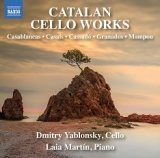Dmitry Yablonsky, der sonst gern als Dirigent der Kviv Soloists Einspielungen vorlegt, ist auf diesem Album als Cellist zu erleben. Seine Begleiterin am Klavier ist Laia Martin. Die beiden Interpreten haben sich hier auf ein Repertoire festgelegt, dass mit der Region Katalonien und dem Instrument Cello verknüpft ist.
Diese Kombination lässt sich aus den beiden katalonischen Cellisten Pau Casals und Gaspar Cassadó, seinem Schüler begründen. Beide waren auch Komponisten bzw. transkribierten Stücke. Weitere auf diesem Album zu hörende Werke haben auch diesen regionalen Bezug durch den Tonsetzer oder das gewählte Sujet. Bei den Stücken handelt es sich zum größten Teil um Charakterstücke bis auf die Sonate Sonata nello stile antico spagnuolo von Cassado.
Die Interpreten bieten diese Werke leichthändig und ohne aufgesetzte Schwere an. Der Cellist entwickelt seine Partien mit sicherer Hand und kann die Musik, die auch mal in für ein Cello ungewohnte Höhen führt, ohne technische Abstriche präsentieren. Laia Martin bietet den Klavierpart gepflegt und sorgfältig einstudiert an. Bei beiden Interpreten hätte man sich noch mehr Charme in der Darbietung gewünscht, um diesen Aspekt der Musik spannungsvoller hören zu können. So wird der musikalische Schatz nicht wirklich gehoben.
Dmitry Yablonsky, who usually likes to make recordings as conductor of the Kviv Soloists, can be heard as a cellist on this album. His accompanist on the piano is Laia Martin. The two performers have chosen a repertoire that is linked to the region of Catalonia and the cello.
This combination can be traced back to the two Catalan cellists Pau Casals and Gaspar Cassadó, his pupil. Both were also composers and transcribers of pieces. Other works on this album also have this regional connection through the composer or the chosen subject. Most of the pieces are character pieces, with the exception of the sonata Sonata nello stile antico spagnuolo by Cassado.
The performers offer these works with a light touch and without any artificial heaviness. The cellist develops his parts with a sure hand and is able to present the music, which sometimes leads to heights that are unusual for a cello, without any technical compromises. Laia Martin offers the piano part in a cultivated and carefully rehearsed manner.
One would have wished for more charm in the performance of both performers in order to hear this aspect of the music in a more exciting way. As it is, the musical treasure isn’t really raised.
























